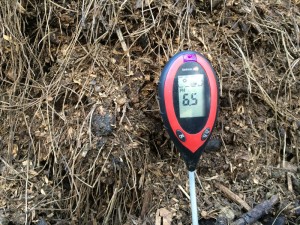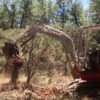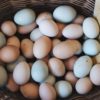A common debate in the gardening / farming community is whether or not pine needles increase compost or soil acidity. In permaculture soil restoration we use large quantities of compost to aid in building soils back to a healthy state.
For our compost we use a large quantity of manure from a farm here in Grass Valley that is free and also full of pine needles. So much so that others would not even take it as they believed that it would be more acidic than without. Their loss or ours?
This begged the question – what was the truth behind pine needles and soil acidity? From a Permaculture standpoint this is important as pine needles are a natural occurring resource and we need to know:
1) Do pine needles effect the PH of compost or soil?
As a Grass Valley Permaculture Designer I wanted to know:
2) What was the PH of the soil around the property?
3) What was the PH of the compost that I was making with the manure that had pine needles in it?
Scientific Studies
I found two studies (and only two) that specifically researched the effect of pine needles on soil acidity: Pine Straw (Pine Needle) Mulch Acidity: Separating Fact From Fiction Through Analytical Testing and Soil pH trends in a sagebrush meadow and Ponderosa pine ecosystem.
Both of these studies conclude that there is no overall measurable acidity increase from pine needles in soil. According to Jacobs:
…my test findings are significant in that the pH of the freshly fallen pine straw leachate was 6.0 at three weeks time. Most pine straw will be at least three weeks old by the time it is harvested, made available for purchase (or gathered yourself), and used in your garden. So the leachate that would reach your plants’ roots and surrounding soil would not only be the equivalent of rainwater, but also in the perfect range for maximum nutrient absorption.
Jacobs did find that there was an initial release of acidity from fresh green pine needles in the first 24 hours but that the impact was near minimal and mitigated by the soil regardless. Delon concludes that:
…the results of this investigation did not yield a statistically significant difference (p > 0.05) in the soil pH of areas with ponderosa pine needle litter and without. All comparisons between soil pH of different depths within the ponderosa pine and mountain sagebrush categories as well as the overall comparison of the categories resulted in p-values above the threshold of 0.05 for statistically significant difference. These data do not support the hypothesis that ponderosa pine needle litter impacts the pH of soil in the sagebrush meadow because there was no consistent pattern found in pH value with depth of soil sampled.
My Studies
 With a simple soil PH meter I went around the property and recorded and averaged a handful of samples from the garden beds, walkways and under the pine trees to get an idea of what the soil PH on site was. Overall it was 5.9 on average – which means the soil was slightly acid (a PH less than 7 is considered acidic).
With a simple soil PH meter I went around the property and recorded and averaged a handful of samples from the garden beds, walkways and under the pine trees to get an idea of what the soil PH on site was. Overall it was 5.9 on average – which means the soil was slightly acid (a PH less than 7 is considered acidic).
We have two hot compost piles going each about 5 yards – one was about 3 months old and the other was brought onsite about a week prior (though it had been sitting in a pile from where I collected it). Interestingly enough both compost piles tested at exactly 6.5 – near neutral PH.
You can see in the photo the amount of pine needles that were in this manure.
Conclusion
Aside from the more obvious conclusions of the studies I felt that I could generally say that at the very least pine needles do not matter in your compost / soil so long as your compost has a more neutral PH than the solid you are adding it to – though that may be pretty obvious as well.
As a permaculture designer we strive to mimic mother nature as much as possible and use as little input as possible for the maximum yield. With this mindset I would personally not worry about pine needles in compost nor spend the time to remove them or sift them out. Additionally there may even be benefit to their presence in the compost as they decompose at a slower rate and are larger than the particles that have already been decomposed – so they may provide habitat for beneficial insects, bacteria and other decomposers that might not otherwise be in there.
I would love to see more studies done on this topic – if anyone has links please post them in the comments below.








